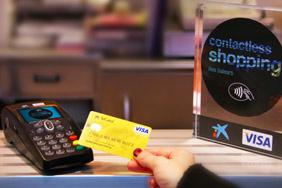Spanish Bank Plans Nationwide Contactless Rollout

La Caixa, one of Spain’s largest banks, has an aggressive plan to roll out contactless cards and point-of-sale terminals nationwide this year and next, a bank spokeswoman told NFC Times.
The rollout would be significant. La Caixa has more than 10.3 million payment cards on issue, the most in Spain, according to the bank. It also has an estimated 21% share of the Spanish card acquiring market, or 150,000 merchants. Plans call for enabling the bank's large network of ATMs to handle contactless cards and NFC phones, as well, said the spokeswoman.
La Caixa announced last month that it would replace 130,000 contactless cards for customers in Mallorca and the rest of the Balearic Islands in May, sending new cards to customers even before they expire. The bank also plans to equip 5,000 shops and restaurants with contactless point-of-sale terminals on the resort islands this month. It announced last week that it had installed what it said were the world’s first contactless ATMs, in three cities.
But the savings bank has decided to adopt contactless well beyond the Balearics. That could include sending contactless replacement cards to cardholders throughout Spain, unsolicited.
"La Caixa is planning to install contactless ATMs around all Spain for 2011 and 2012," a bank spokesperson told NFC Times. "We expect that all our clients can have contactless cards and all our merchants can have contactless payment devices at the end of 2012."
If true, that aggressive schedule will be hard to meet. To date, no Spanish bank has rolled out either contactless cards or POS terminals. La Caixa's announcement last month of its contactless project in the Balearics represents the first move by a Spanish financial institution to contactless payment, outside of card and NFC phone trials.
At least one other large Spanish bank, Banco Santander, has expressed strong interest in rolling out contactless cards and terminals, a source told NFC Times. The bank, however, has made no announcements yet. Rollouts by La Caixa, Santander and others, if implemented, would make Spain one of Europe’s contactless hotspots and underpin NFC rollout plans by the country’s largest mobile operator, Telefónica España, which recently launched another large NFC trial at its headquarters. The project, which could eventually put NFC phones in the hands for 12,500 employees, launched last month with 1,000 people. It is seen as a prelude to a general NFC rollout by the telco to its subscribers.
In the trial, employees can pay for purchases and access work areas by tapping their Samsung S5230 NFC phones. Payment and access control applications are stored on Telefónica SIM cards.
La Caixa is one of three banks involved in this trial, along with BBVA and Bankinter. La Caixa and Telefónica also held a high-profile NFC trial last year involving 1,500 customers and 500 merchants in the resort town of Sitges, near Barcelona. In both trials, the bank issued a Visa payWave, contactless application.
La Caixa, which has also been among the most aggressive banks in rolling out Internet and mobile banking, with 1.8 million customers in the latter category, told NFC Times last week that so far it had only installed three contactless ATMs, one each in Barcelona, Sitges and Palma. The savings bank has 8,000 ATMs, which is the largest network in Spain.
They are believed to be the first contactless cash machines in operation anywhere. (ATMs secured by biometrics in Japan do not use contactless technology).
Figures from the maker of the contactless system for the Spanish ATMs, Japan-based Fujitsu, put average times for contactless cash withdrawals at 26 seconds–12 seconds faster than the average cash withdrawal using conventional cards, according to the bank, which said it confirmed the figures for the transaction times.
"Contactless cards need not be inserted into the ATM card slot before transactions can be performed," the bank said last week in a statement. "Instead, users need only wave their cards next to the reader and enter their PIN to operate the ATM."
The bank added that the contactless withdrawals are "fully secure." And in response to a question from NFC Times about the possibility of eavesdropping on contactless cards to steal data, the bank noted the cards are "protected by EMV security protocols and, obviously, by the personal PIN code."
"Anyway, a fraudster would have to intercept transmissions in the 2 to 3 centimeters between the card and the contactless ATM reader. If someone tried it, the customer would realize (it)," the bank said.












